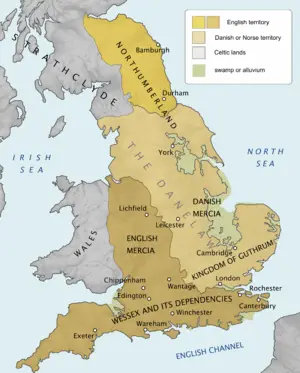How Historically Accurate is Season 2 of Last Kingdom
Warning: This article contains spoilers!!!!
Check out our summaries for Season 1, Season 3, and Season 4.
The Last Kingdom is a historical-based series set in Anglo-Saxon England in the 9th century AD during a time of major Viking (Norse and Dane) invasions. Season 2 focuses on family conflicts that embroiled Uhtred, the protagonist, and the conquest of London, an actual historical event.
Set of Events
Season 2 is divided into two novels from the Saxon Tales series written by Bernard Cornwell, namely books 3 and 4 (Season 1 was books 1-2). The novels span roughly between 878-886 (Figure 1). The main focus for Season 2 in the first four episodes is Uhtred's quest to go north from Wessex into Northumbria, a less tamed area of England that is ruled more by Danes but their hold is somewhat less clear. Uhtred seeks his ancestral home in Bebbanburg (Bamburgh Castle) and also wants revenge against Kjartan, who killed his adopted Danish father.[1]
Uhtred finds himself helping a Dane, King Guthred, who was a slave envisioned to be a king by priests serving Saint Cuthbert, specifically abbot Eadred. This was a period after Halfdan, a Dane, had conquered Northumbria. Guthred was indicated to be Hardcanut's son, who somehow ended up in slavery. The story of Guthred being freed is depicted in the first episode, as he is rescued by Uhtred. The crowning of Guthred was preceded by a period of some anarchy, as the population arose against the Danes. Historically, there was uncertainty after Halfdan was killed in battle as he was fighting in Ireland. This was used by the series to create the context in which Guthred came to power.
Later, after Guthred was crowned as king of Northumbria, Uhtred became the leader of Guthred's household guard. Much of the rest of the first four episodes are not so much historical but more focused on Uhtred and the revenge exacted against Kjartan. The only main highlight is the focus on Dunholm, which was the base of Kjartan. Dunholm, modern Durham, is little known historically at this time, although it may have had an important fortress already in the Anglo-Saxon period, as suggested by the series. Overall, the first episodes show that in parts of England, Danish and English people were becoming intermixed, where some Danes, such as possibly Guthred, became Christian as well. In effect, the population was become hybrid and some conversions were taking place to make the Vikings Christians.[2]
In the last four episodes, the focus is a few years after the events where Uhtred had helped his Danish brother, Ragnar the Younger, to take Dunholm. Now, Uhtred is based in Cookham, a small village near London which was, in fact, occupied as a more prominent settlement in Anglo-Saxon times. Once again, Uhtred had sworn allegiance to Alfred, after Alfred had helped free Uhtred from slavery. It shows Uhtred as leading Alfred's borough of Cookham. In fact, Cookham was the last important borough before reaching London. Overall, England is divided into Danelaw, areas in northern Mercia, Northumbria, and East Anglia, and Wessex, which also ruled over southern Mercia. London in 886 was little known and the historical accounts simply mentioned that Alfred had restored the town, including rebuilding its Roman walls. The series shows the events in a more theatrical manner, showing the Norse had, initially, taken the city. Then, they tricked the Anglo-Saxons in allowing them to take the city so that the Lady Æthelflæd could be captured. The series concludes with Uhtred leading a daring rescue that saw her freed.[3]
Historical Characters
The series develops several significant characters that were introduced in the first season. The first being Æthelflæd, who is now of marriageable age. She is to become be an important historical figure in leading Mercia to full independence from Viking occupation. Her parents marry her to Æthelred, who is Lord of Mercia, (the areas of Mercia free from Danish rule) n order to form a strategic alliance between Wessex and Mercia. The marriage is portrayed, however, as unhappy. Æthelred is depicted as abusive and as marrying Æthelflæd solely in order to advance his position with her father, King Alfred. There is some historical account to suggest they had an estranged or less than happy marriage, although the two did form an important political combination in Mercia.[4]

Another key character introduced in the first four episodes is Guthrud. He was likely a Dane and he may have been a Christian. It is unclear if he really was a slave, but accounts do suggest that was the case. While Alfred was shown as scheming to help make him king, the reality is less clear. He may have simply become king because the population of Northumbria was becoming increasingly intermixed and having a ruler showing greater sympathy to the Danes and Christian Anglo-Saxons may have suited everyone in Northumbria. He also may have simply succeeded normally as any Dane would, but the Anglo-Saxons tried to make it look legitimate through the stories of St. Cuthbert selecting him. There is a story that St. Cuthbert's body did not decay and, in the series, he is shown as relatively well preserved, as his corpse is used to give the new king Guthrud his blessing.[5]
One of the Vikings was Haestein, who seems to be a key aid to the leader Norse in the series, namely the brothers Sigefrid and Erik. While Siegfried and Erik seem fictional, Haestein who may have come to England in the late 9th century and launch some devastating attacks. His role, however, in this season is more minimal, focusing on his support of the two Norse brothers.[6]
The story also introduces Osferth, who likely was Alfred's illegitimate son. The historical records on him do not make it clear, and in the series he is shown as a monk who wants to join Uhtred's warriors. There does exist records from Alfred's will that suggests Osferth was a son of Alfred's, where he is called kinsman, and he even held some important positions as ealdorman in historical texts.[7]
The other key characters were introduced in Season 1, such as Alfred. Uhtred is a fictional character, although historical characters with that name and from Bebbanburg are, in fact, known.
How Accurate is the Story?
Season 2, which focused more heavily on Uhtred's trials as he became a slave, got married to Guthrud's sister, and his assistance in taking London and rescuing the Lady Æthelflæd. As this was a period of relatively less conflict, in comparison to Season 1, the series did take more liberties in interpreting historical events. For instance, while Guthrud may have come from a famous Viking father and may have been a slave, relatively little is known about how he ruled.
In the series, he is shown as a weak and easily pliable king, acting to his own detriment and that of Uhtred's. Alfred marrying his daughter Æthelflæd is shown as an important move to unite Mercia and Wessex. This is historically accurate and it likely did cause tension between the two kingdoms as the former powerful kingdom of Mercia became more closely associated with Wessex. The taking of Lady Æthelflæd is, however, a likely fictional event. In effect, there are not a large number of historical events, but the places, such as Cookham, key events (e.g., taking of London), and some of the key characters (e.g., Guthrud and Osferth) are historical. Because relatively little is known about this period, such as how London was taken, the writers were able to add their own version of events to make it an interesting story.
Summary
Season 2 shows key historical events, the taking of London and the beginning of rulers who were Christian and Danish, possibly changing the character of the country even as it was ruled by Danes. The unity of Mercia and Wessex is also shown, including how that process developed. The series indicates how the attempt by the Norse, in this case, Siegfried and Erik, failed to take over England. The establishment of the boroughs, indicated in Series 2, were critical in thwarting Viking raids in England, which were indirectly shown and discussed in the series. Overall, however, as the years in which the events took place were relatively quiet, there was more liberty for the series to focus on character stories such as Uhtred and his brother Ragnar taking back Dunholm.
References
- Jump up ↑ For more on the series, see: https://en.wikipedia.org/wiki/The_Saxon_Stories
- Jump up ↑ For more on the historical Guthred, see: Campbell, J., John, E. & Wormald, P. (1991) The Anglo-Saxons. London, England ; New York, N.Y., USA, Penguin Books, pg. 81.
- Jump up ↑ For more on the events leading to 886, see: Inwood, Stephen (1998) A history of London. London, Macmillan, pg. 64.
- Jump up ↑ For more on Æthelred and Æthelflæd, and their role in uniting Mercia and Wessex, see: Marafioti, N. (2014) The king’s body: burial and succession in late Anglo-Saxon England. Toronto Anglo-Saxon series. Toronto, University of Toronto Press, pg. 58.
- Jump up ↑ For more on St. Cuthbert, see: Marner, D. & British Library (2000) St. Cuthbert: his life and cult in medieval Durham. Toronto; New York, University of Toronto Press.
- Jump up ↑ For more on Haestein, see: Craughwell, T.J. (2008) How the barbarian invasions shaped the modern world: the Vikings, Vandals, Huns, Mongols, Goths, and Tartars who razed the old world and formed the new. Beverly, MA, Fair Winds Press, pg. 199.
- Jump up ↑ For more on Osferth, see: Abels, R.P. (1998) Alfred the Great: war, kingship, and culture in Anglo-Saxon England. The medieval world. Harlow, England ; New York, Longman, pg. 48.
Related DailyHistory.org Articles
- How Historically Accurate is season 1 of The Last Kingdom?
- Is Oliver Stone's movie 'Nixon' historically accurate?
- How historically accurate is the movie The Longest Day?
- How historically accurate is the movie 'The Battle of the Bulge'?
- Privateering during the War of 1812: Interview with Faye M. Kert
- Is the movie Dunkirk historically accurate?

